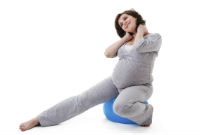Physical Changes in the Fifth Month of Pregnancy
As in the fourth month, both you and your baby grow rapidly during the fifth month of pregnancy. You will probably gain around five pounds, and your baby’s weight will nearly double. Naturally, you will feel these physical changes. During this month, women often exclaim: “All of a sudden I’ve popped out” when referring to their abdomen and breasts. Some specific physical changes you may notice during the fifth month of pregnancy include the following.
Showing More
Much of your look while carrying a baby reflects the body type you inherited from your mother and father. Tall, slim women tend to show later and higher; short and wide women tend to show earlier and lower. Long-waisted women (versus short-waisted women) have more room for the uterus to grow up before it has to grow out, so they tend to show later.
Itchy and Sensitive Belly
Stretching skin itches. That’s a dermatological fact. Massage a soothing emollient into the itchy areas. Beginning around the fourth or fifth month of pregnancy, you may not want to wear anything that binds on your belly or to lie on it.

Navel Discomforts
Around twenty weeks, your expanding uterus presses outward beneath your belly button. It may hurt slightly when you walk. You may now experience occasional, minor discomforts in the area beneath your navel, and the navel itself may suddenly pop and become an “outie.” (It will return to normal after delivery.)
Your nipples may start to be more sensitive than ever during the fifth month of pregnancy, especially when you are lying on them during sleep or when they rub against your clothing. You may also notice leaking colostrum, a golden yellow substance that is the first milk for your newborn.
Cramping During the Fifth Month of Pregnancy
As early as the fifth month of pregnancy, some women, especially those in their second or subsequent pregnancies, experience abdominal discomfort similar to but less intense than menstrual cramps. These tiny contractions are a prelude to warm-up contractions called Braxton Hicks, which are more frequent and more noticeable during the third trimester.
Abdominal Pain
The tissue surrounding and supporting your uterus has more work to do now that your uterus is bigger and heavier. This brings new physical sensations. Large ligaments, called round ligaments, on each side of your uterus, attach your uterus to your pelvis. Round ligaments must stretch as your uterus grows. This slow and steady stretching does not cause discomfort, but because they are being taxed by change, round ligaments can suddenly become sensitive to normal actions.
The most common offender is a sudden change of position. When you twist or get out of bed in the morning, round ligament strain can cause a gripping pain along one or both sides of your lower abdomen or even toward your back. While not harmful to the baby, this pain can sometimes be excruciating for you. To prevent or lessen pelvic-ligament pain, try leg lift exercises. Avoid sudden changes of position, especially from sitting to standing and when getting out of bed.
Try lying down on your side, either the side of the pain or the opposite one – whichever brings you more relief. If you need more relief, try a hot water bottle.
Changes in Vision
Sometime around the fifth month of pregnancy, many women find their vision changes, usually for the worse. The increased fluid retention throughout your body actually changes your eyeballs’ shape, and with it, your vision. Some women become more far-sighted, some more near-sighted during pregnancy.
You may feel you need a change in the prescription of your glasses, or your contact lenses may become uncomfortable as if they no longer fit. Another cause of vision changes in pregnancy is the drop in estrogen, which decreases the moisture available to your eyes (dry-eye syndrome). It can lead to blurred vision, light sensitivity, and red, burning eyes.
Feet are Growing During the fifth Month of Pregnancy
If you feel your feet are getting larger and heavier as your abdomen does, you are right. That’s the fluid collecting in your ankles and feet, especially after a day of standing. Feet also feel the effects of the normal ligament looseness that develops throughout your body, causing weight-bearing joints to stretch and widen and arches to fall. The extra body fat you are accumulating doesn’t help any.
Put all these changes into a shoe, and it’s no wonder that it no longer fits. Most women require at least a half-size larger shoe starting around the fifth month of pregnancy, and around fifteen percent of moms permanently require footwear at least a half-size larger.
For more information on pregnancy, see The Healthy Pregnancy Book: Month by Month, Everything You Need to Know from America’s Baby Experts
Dr. Sears, or Dr. Bill as his “little patients” call him, has been advising busy parents on how to raise healthier families for over 40 years. He received his medical training at Harvard Medical School’s Children’s Hospital in Boston and The Hospital for Sick Children in Toronto, the world’s largest children’s hospital, where he was associate ward chief of the newborn intensive care unit before serving as the chief of pediatrics at Toronto Western Hospital, a teaching hospital of the University of Toronto. He has served as a professor of pediatrics at the University of Toronto, University of South Carolina, University of Southern California School of Medicine, and University of California: Irvine. As a father of 8 children, he coached Little League sports for 20 years, and together with his wife Martha has written more than 40 best-selling books and countless articles on nutrition, parenting, and healthy aging. He serves as a health consultant for magazines, TV, radio and other media, and his AskDrSears.com website is one of the most popular health and parenting sites. Dr. Sears has appeared on over 100 television programs, including 20/20, Good Morning America, Oprah, Today, The View, and Dr. Phil, and was featured on the cover of TIME Magazine in May 2012. He is noted for his science-made-simple-and-fun approach to family health.

